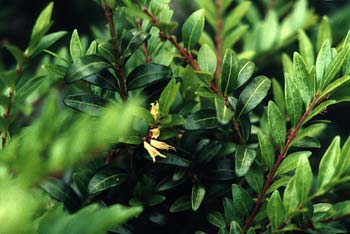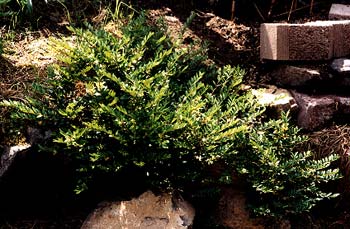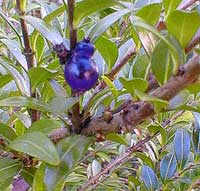 Privet Honeysuckle
Privet Honeysuckle
Privet Honeysuckle (Lonicera pileata), also called Boxleaf Honeysuckle, is generally under three feet tall, but can put on considerable width over time, five foot spread being common, with an eight foot spread possible. It's amenable to pruning after it flowers, or can be left to spread as a hillside groundcover. It easily roots a new plant from any horizontal branch bent to the ground & planted, or from cuttings. It's an excellent substitute for over-utilized box shrubs. It's one drawback is brittleness; you wouldn't want to plant it on a hillside that anyone would be tramping down knocking into the limbs.
 This native of China scarsely looks like a honeysuckle, more closely resembling a box shrub or pernettya or vaccinium. It likes sun to part shade. Ours is in a sunny location on an embankment that doesn't receive a lot of waterings. It has proven hardy in this location, & has been four-fifths to fully evergreen, though in cooler zones it will be semi-evergreen. It puts on width with relative swiftness, tolerates most soils, & even tolerates coastal salt spray conditions.
This native of China scarsely looks like a honeysuckle, more closely resembling a box shrub or pernettya or vaccinium. It likes sun to part shade. Ours is in a sunny location on an embankment that doesn't receive a lot of waterings. It has proven hardy in this location, & has been four-fifths to fully evergreen, though in cooler zones it will be semi-evergreen. It puts on width with relative swiftness, tolerates most soils, & even tolerates coastal salt spray conditions.In April it develops tiny green capsule-shaped buds that can easily go unnoticed. In May these open into tubular yellowish cream-colored blooms that lend the shrub a fragrance but which are not all that significant since the flowers are small & tucked amidst the leaves. The May extreme close-up photo of one of these flowers is bigger than life-size by two. Even when noticed they're not much of an addition, though I find even such plain tiny flowers of interest.
 The nondescript flowers become violet-blue transluscent Autumn berries. These are most evident September through November; a few of the berries will last through the winter. In the third photo snapped the last day of October, you can see a couple of the berries in close-up, considerably enlarged. They are scarsely noticeable from any distance as they are tucked under the little leaves, yet most charming upon close inspection. The berries have a dimple that make them look like tiny hard candies, with emphasis on "tiny." The species name pileata means "cap-shaped," alluding to these dimpled berries.
The nondescript flowers become violet-blue transluscent Autumn berries. These are most evident September through November; a few of the berries will last through the winter. In the third photo snapped the last day of October, you can see a couple of the berries in close-up, considerably enlarged. They are scarsely noticeable from any distance as they are tucked under the little leaves, yet most charming upon close inspection. The berries have a dimple that make them look like tiny hard candies, with emphasis on "tiny." The species name pileata means "cap-shaped," alluding to these dimpled berries.Charming & marvelously colored though they are, these eency fruits will be scattered thinly through the bush, & are so small you have to look for them hidden amidst leaves. The first two years the berries were exceedingly few & tiny & even disappointing, but its third year, the berries were quite wonderful to see, though one still had to make a point of noticing them. For another view of the third-year violet berries, see the Privet Honeysuckle Page of the Berries Gallery.
Privet honeysuckle so overdoes the notion of subtlty that they can be slightly disappointing if a gardener was expecting the glassy blue-violet fruit to be as overt as are vining honeysuckles' glassy red fruit. But even with the fruits' excessive subtlty, the shrub itself is so handsome & hardy, it should be a preferred groundcover choice in lieu of similar shrubs that would need more watering or which, like boxes, are just too commonly used.